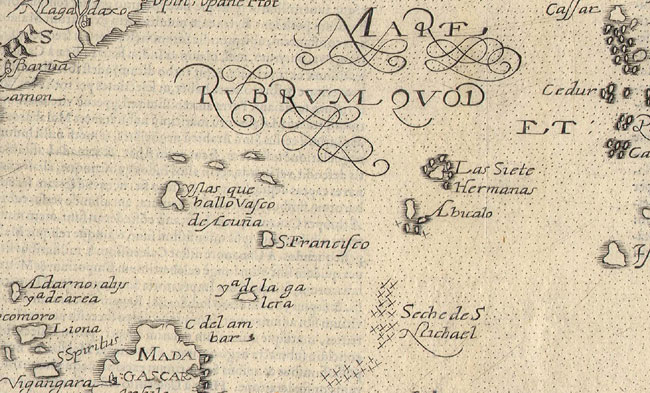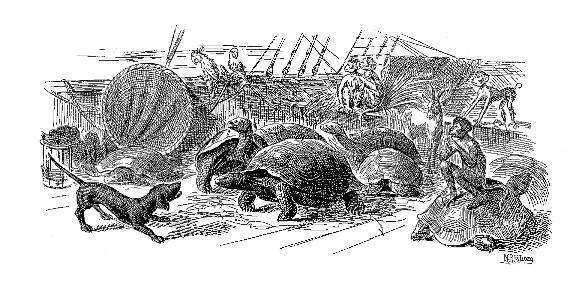|
History
The
Seychelles first appeared on Arab charts of the 9th century as the
“Tall Islands”. It is likely that the ships of the expedition of Pedro
Alvarez Cabral in 1501 have sighted the islands. Vasco Da Gama in 1502 only saw
the Amirantes, while Joao de Nova already discovered the Farquhar group in 1501.
On Portuguese maps from this period the islands called “The Three Brothers”
and “The Seven Sisters” probably refer to the actual Seychelles.

In the
morning of the 19th of January 1609, Mr. Jones, the boatswain from
the Ascension was the first to see land when his ship entered the waters of the
Seychelles. This brig from the “East Indian Company”, under the command of
general Alexander Sharpeigh, was on its way to Aden. The two company traders,
John Jourdain and William Revett, who were on board, had the task to establish
trade relations with Aden and Surat. After being attacked by natives near the
Portuguese island of Pemba, the Ascension escaped to the east, but the
prevailing northeast monsoon made it impossible to continue straight to Aden,
and during this off-course stretch, land was sighted. In need of fresh water,
the Ascension anchored in front of North Island, about 5 km North of Silhouette.

They found a lot of giant tortoises, the bigger ones weighing between 500 and
600 pounds. In the ships log boatswain Jones wrote "The tortells were good
meate, as good as fresh beefe, but after two or three meales our men would not
eate them, because they did looke soe uglie before they were boyled." William
Revett recorded in his journal: "we fownde land turtles of such bignes
which men would think incredible; of which our company had small lust to eat of,
being such huge deformed creatures and footed with five claws lyke a
beare." John Jourdain in his journal also records: “where wee found many coker nutts, both ripe and greene, of all sorts, and much fishe and fowle and
tortells and many soates with other fishe. As alsoe aboute the rivers there are
many allagartes (crocodiles); our men fishinge for scates tooke one of them and
drewe him aland alive with a rope fastened within his gills. Within two miles
where we roade, there is a good tymber as ever I sawe of length and bignes, and
a very firme timber. You shall have many trees of 60 and 70 feete without
spriggs except at the topp, very bigge and straight as an arrowe. It is a very
good refreshing place for wood, water, cooker nutts, fish and fowle, without any
feare or danger except the allagartes for you cannot discerne that ever any
people had bene there before us." After 13 days, the first of February, the
Ascension left the Seychelles for Aden. A few months later the Ascension was
wrecked on a bar as it entered Surat. The ship and the cargo were lost but the
crew survived. The ship's log and
Jourdain and Revett's journals are the first records of Europeans landing on the
Seychelles.
Cracked
down by the British Navy in the late 17th century, and attracted by
the tales of the wealth of the Orient, many pirates from the West Indies steered
for the Indian Ocean. Between 1700 and 1720 no less than eleven of their ships
that used to sail in the Caribbean were identified in Indian Ocean waters. The
Seychelles being an ideal refuge were certainly visited by these pirates. It
took one and a half century before the next visit by men to the islands was
recorded. The French governor on Mauritius, Le Visconte Bertrand-François Mahé
de La Bourdonnais, sent Lazare Picault on expedition to the Seychelles for the
first time in 1741 with the Elizabeth, but he ran off course, and just sighted
the islands, and sailed back to Mauritius. After his report he was sent back by
the governor and on board of the Elizabeth in company of the Saint Charles
captained by Jan Grossin, he landed on Mahé on the 11th of November
in 1742. He was so impressed that he christened the island; Ile d’ Abondance.
He left after only 4 days taking 300 giant tortoises and 600 coconuts. 14 years
later in 1756, on the 9th of November, the Irish sea captain
Corneille Morphey, sent by the new governor on Mauritius René Magon, laid
official claim on all the islands in the name of the French king Louis XV by
laying a stone of possession. He named the islands after the French minister of
finance at that time; Vicomte Moreau de Séchelles. The name Silhouette was given after
Etienne de Silhouette (1709-1767), the French controller (minister) of finances,
under Louis XV in 1759, and a protégé from Madame de Pompadour. He was not that
successful, he was only in charge from the 4th of March 1759 till the 21st of
November the same year. He made the mistake to raise the taxes for “la
noblesse”. Some guides write the name Silhouette should be given after the
marvellous “silhouette” you have from the island sitting on the beach of
Beau Vallon. But on the contrary, the word “silhouette” comes from Etienne
de Silhouette.
On
the 28th of January 1771, during a French expedition from Mauritius, lieutenant
Charles Oger, officer of L' Heure du Berger, under command of Chevalier du
Roslan, took a formal possession of Silhouette .
|
